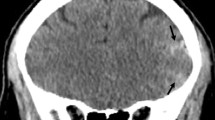Opinion statement
Reversible cerebral vasoconstriction syndromes (RCVS) comprise a set of conditions having in common the apoplectic onset of headache mimicking subarachnoid hemorrhage, focal or multifocal neurologic deficits with a predilection for visual processing disorders, multifocal vasoconstriction on cerebral angiography, noninflammatory spinal fluid, and a generally benign prognosis. RCVS may occur in the setting of the puerperium, after intracranial surgery, in association with prescription or illicit drug use, in migraineurs, or without a clear trigger. Distinction from central nervous system vasculitis is important and is often possible using routine clinical assessment, without brain biopsy. No treatments are of proven value in RCVS. Empiric treatments include the use of calcium channel blockers, steroids, induced hypertension or blood pressure lowering, and rarely endovascular therapy. The key to successful management is accurate diagnosis and cognizance of the tendency of RCVS to resolve without long-term immunosuppressive treatment.
Similar content being viewed by others
References and Recommended Reading
Singhal AB, Bernstein RA: Postpartum angiopathy and other cerebral vasoconstriction syndromes. Neurocrit Care 2005, 3:91–97. This article extensively reviews the historical and current literature on diagnosis, etiology, and management of RCVS.
Jackson M, Lennox G, Jaspan T, Jefferson D: Migraine angiitis precipitated by sex headache and leading to watershed infarction. Cephalalgia 1993, 13:427–430.
Singhal AB, Caviness VS, Begleiter AF, et al.: Cerebral vasoconstriction and stroke after use of serotonergic drugs. Neurology 2002, 58:130–133. This article highlights an important and frequently overlooked cause of RCVS.
Call GK, Fleming MC, Sealfon S, et al.: Reversible cerebral segmental vasoconstriction. Stroke 1988, 19:1159–1170.
Hajj-Ali RA, Furlan A, Abou-Chebel A, Calabrese LH: Benign angiopathy of the central nervous system: cohort of 16 patients with clinical course and longterm follow-up. Arthritis Rheum 2002, 47:662–669. This article highlights the important differences between RCVS, referred to here as benign angiopathy, and true PACNS.
Nighoghossian N, Derex L, Trouillas P: Multiple intracerebral hemorrhages and vasospasm following antimigrainous drug abuse. Headache 1998, 38:478–480.
Sugiyama Y, Muroi A, Ishikawa M, et al.: A benign form of isolated angiitis of the central nervous system in puerperium: an identical disorder to postpartum cerebral angiopathy? Intern Med 1997, 36:931–934.
Singhal AB: Postpartum angiopathy with reversible posterior leukoencephalopathy. Arch Neurol 2004, 61:411–416.
Schluter A, Kissig B: MR angiography in migrainous vasospasm. Neurology 2002, 59:1772.
Kaye BR, Fainstat M: Cerebral vasculitis associated with cocaine abuse. JAMA 1987, 258:2104–2106.
Day JW, Raskin NH: Thunderclap headache: symptom of unruptured cerebral aneurysm. Lancet 1986, 2:1247–1248.
Calabrese LH, Duna GF, Lie JT: Vasculitis in the central nervous system. Arthritis Rheum 1997, 40:1189–1201.
Woolfenden AR, Tong DC, Marks MP, et al.: Angiographically defined primary angiitis of the CNS: is it really benign? Neurology 1998, 51:183–188.
Edlow JA, Caplan LR: Avoiding pitfalls in the diagnosis of subarachnoid hemorrhage. N Engl J Med 2000, 342:29–36.
Geraghty JJ, Hoch DB, Robert ME, Vinters HV: Fatal puerperal cerebral vasospasm and stroke in a young woman. Neurology 1991, 41:1145–1147.
Meschia JF, Malkoff MD, Biller J: Reversible segmental cerebral arterial vasospasm and cerebral infarction: possible association with excessive use of sumatriptan and Midrin. Arch Neurol 1998, 55:712–714.
Ringer AJ, Qureshi AI, Kim SH, et al.: Angioplasty for cerebral vasospasm from eclampsia. Surg Neurol 2001, 56:373–378; discussion 378–379.
Schwab S, Steiner T, Aschoff A, et al.: Early hemicraniectomy in patients with complete middle cerebral artery infarction. Stroke 1998, 29:1888–1893.
Author information
Authors and Affiliations
Rights and permissions
About this article
Cite this article
Bernstein, R.A. Reversible cerebral vasoconstriction syndromes. Curr Treat Options Cardio Med 8, 229–234 (2006). https://doi.org/10.1007/s11936-006-0016-8
Issue Date:
DOI: https://doi.org/10.1007/s11936-006-0016-8




